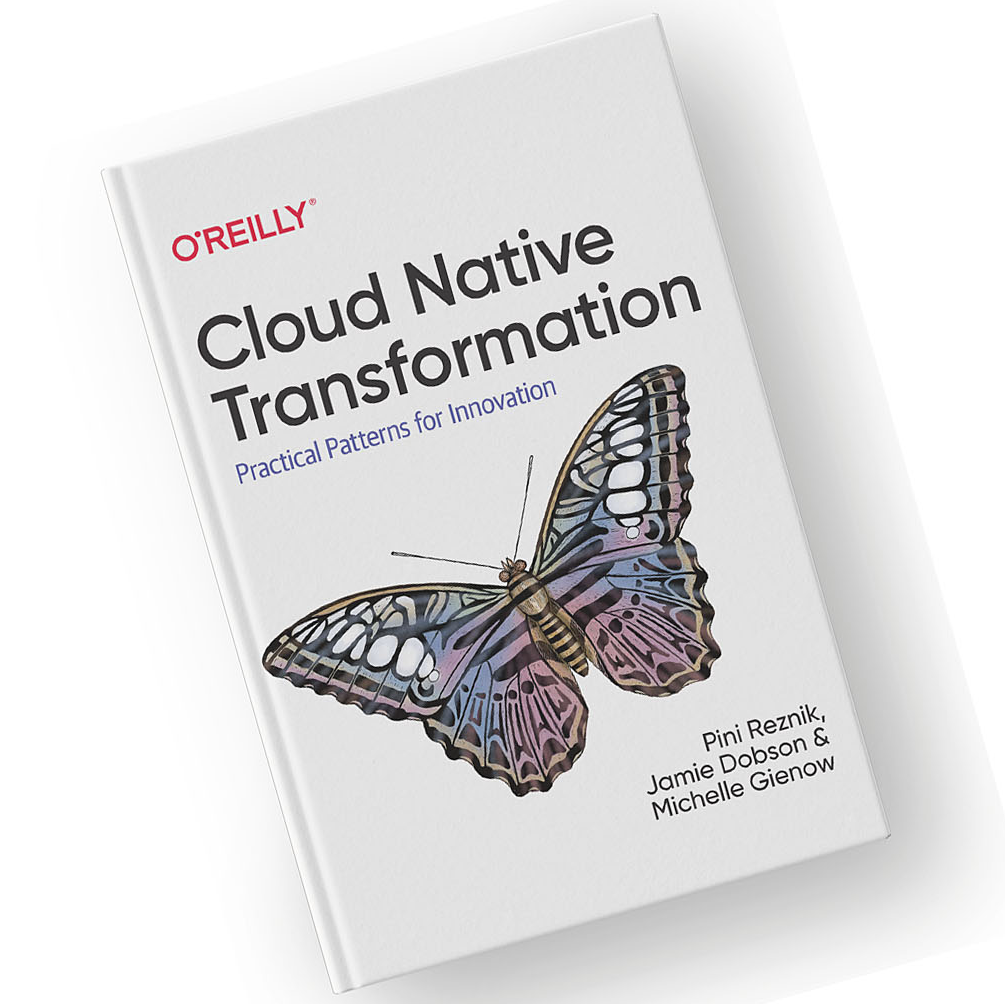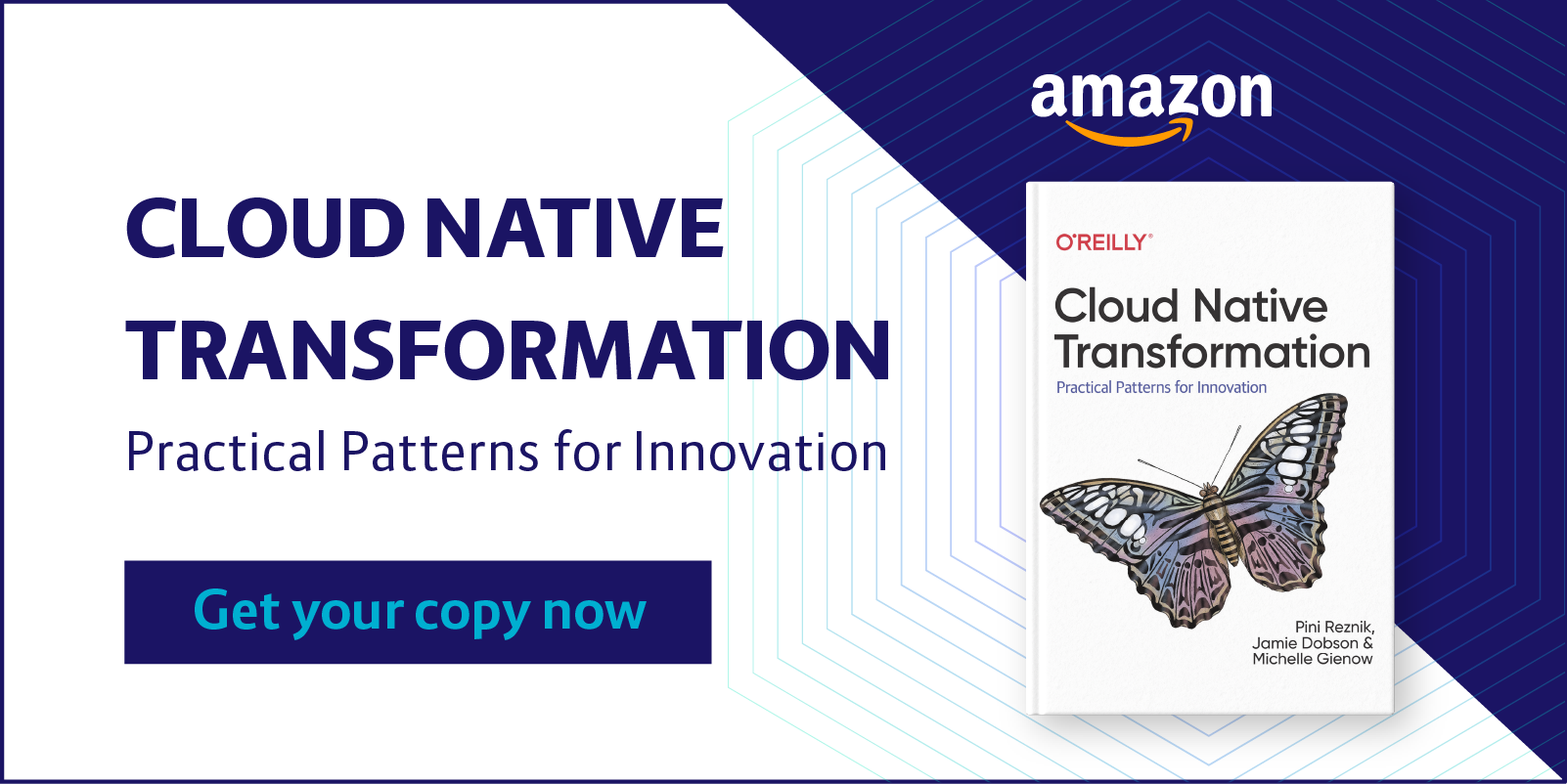It is with great pride, and no small measure of relief, that we announce the publication of our new book from O’Reilly Media. As of this week, copies of ‘Cloud Native Transformation: Practical Patterns for Innovation’ are available for digital download, though if you prefer the analog version those won’t be available until 24 December. (Apologies if that messes up your holiday gift list. In the meantime, you can get a free excerpt here).

While debugging the final layout of the book, last stop before sending it to the printer, I came across the copyright page that the O’Reilly production team had inserted. This is where they put all the official 'don’t sue us' boilerplate language, it was certainly not something Pini, Jamie, or I had written. It read, in part:
While the publisher and the authors have used good faith efforts to ensure that the information and instructions contained in this work are accurate, the publisher and the authors disclaim all responsibility for damages resulting from the use of or reliance on this work.
Use of the information and instructions contained in this work is at your own risk.
OK. Wow. Well, I would like to take this opportunity to say that the whole reason we wrote this book is to help reduce the risk inherent in a Cloud Native transformation!
Yes, transformation is a risky proposition, but so is facing the future without taking any steps to anticipate or respond to change. Things are moving faster than ever before, and so we brought a tone of urgency to our message: evolve or die. And so we certainly take responsibility for sharing our best understanding of the current Cloud Native space, and the best methods for transforming an organisation’s existing technology and culture for taking advantage of it.
Starting Over
Initially, we planned to put out a more typical (and much shorter) book about Cloud Native software design patterns. We pitched a fairly standard reference-manual approach: Here is a library of patterns, read through them and figure out which ones fit your needs, then follow the steps.
This academic approach is easy on the authors, but it’s really only useful for readers who already know what they’re doing. It would be aimed at those experienced enough to understand the problem, or set of problems, that they are facing, and so only need to seek an optimal solution.
We quickly came to see, however, that we were writing a book that that wouldn’t be a lot of help to most, if any, of our actual clients.
When real world companies start looking to go Cloud Native, they are looking first and foremost for basic understanding. They don't need another tech book about best practices for Kubernetes cluster management—they need to know a bunch of stuff that comes before that part. Like, for starters, what a Cloud Native transformation even looks like, functionally speaking, inside an organisation. What to expect, what a realistic timeframe would be, what kind of budget and resources to allocate, who needs to do what.
In other words, a lot of things must come before your teams get to play with Kubernetes (though we definitely do get you there, and surprisingly quickly).
This seemed to be the part nobody was talking about, though we could plainly see it was essential for success. So that’s when we decided our book would be about all the stuff that comes first, the strategy and architecture and involving the entire organisation in the transformation from the start, as well as the technical parts of the transformation.
The Avoidable Kind of Risk
There is risk involved, because moving to Cloud Native means not just changing your technology but also your whole way of working with it. But after working with companies from many different sectors, with many different needs and many different approaches, we came to see that the process actually involves only two kinds of risk.
One is unavoidable, but manageable: the risk inherent in undertaking a complex global transformation of your company’s tech and processes. Our book shows you many tools, methods, and strategies for making this process safe, iterative, and responsive—in other words, de-risking the transformation process by defining the right high-level path, then continually refining and adjusting as you go.
The other kind of risk is completely avoidable, though we have observed all kinds of companies blunder straight in nonetheless . . . and then pay the price.
This second category is approaching a Cloud Native transformation as just some new technology to be adopted: spend a lot of money, a painful week or month moving everything over, then you’re good to go for five or 10 more years. This single, fundamental misunderstanding of what Cloud Native actually means leads directly to a wide variety of problems arising from all areas of an org, from development to operations to leadership.
We show you exactly how it happens, and why so many otherwise successful enterprises end up falling into this trap. We walk you through the common pitfalls and show you how to avoid them. Then we hand you the tools for building your own trail through this tricky landscape, with us as your guide, applying patterns in a custom transformation design that will see you safely and quickly through.
The best part being that, once on the other side, you’re not just a company that’s successfully gone Cloud Native. You’re now a company that’s learned how to dynamically evolve simply as part of your everyday existence. Meaning that you no longer have to fear change, because you’re ready to handle whatever comes next. And—spoiler alert—that was the real reason we wrote this book.
We don’t want to teach you how to ‘do’ Cloud Native, though that is an important first step. What we are truly trying to do is help you become a responsive and adaptive organization, able to move fast to whatever comes next—without breaking things.



 Previous article
Previous article
